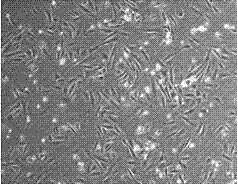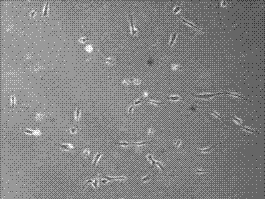Novel menstrual blood-derived mesenchymal stem cell separation method
A technology of mesenchymal stem cells and separation method, applied in the field of new menstrual blood-derived mesenchymal stem cells, can solve the problem of less MSCs, achieve good antibacterial effect, improve survival rate, and inhibit fungal infection
- Summary
- Abstract
- Description
- Claims
- Application Information
AI Technical Summary
Problems solved by technology
Method used
Image
Examples
Embodiment 1
[0028] Treat ten menstrual blood from different age sources, divide them evenly into two parts, mark the distribution as sample A and sample B, and separate sample A by the method provided by the present invention. The details are as follows:
[0029] A novel method for isolating menstrual blood-derived mesenchymal stem cells, comprising the following:
[0030] a. Collection of menstrual blood: transfer the menstrual blood to phosphate buffered saline 1-2 times the volume of menstrual blood to obtain a mixture, and store the mixture at 4°C;
[0031] The pH value of the phosphate buffer is 7.2, and the phosphate buffer includes EDTA with a mass concentration of 5ug / ml, sodium citrate of 50ug / ml, trehalose of 50-100mg / ml, 0.03- 0.05mg / ml penicillin, 0.05~0.1mg / ml streptomycin, 0.05~0.1mg / ml fluconazole.
[0032] b. transfer the mixture obtained in step a within 48 hours to an equal volume of PBS buffer and mix well, then filter through a 200-mesh sieve to obtain the filtrate, a...
Embodiment 2
[0048] Process ten parts of menstrual blood from different age sources, divide evenly into two parts, and mark the distribution as sample A and sample B, extract with traditional extraction methods and the method of the present invention (embodiment 1) respectively and from the contamination probability of samples , Extracted cell morphology and cell purity for comparison. Sample B is carried out by the traditional method, and the details are as follows:
[0049] Traditional menstrual blood-derived mesenchymal stem cell isolation methods include the following:
[0050] a. Collect menstrual blood: store menstrual blood sample A in phosphate buffered saline PBS containing 0.2ml amphotericin B and 0.2ml penicillin mixture, and store at 4°C;
[0051] b. Transfer the mixture sample A obtained in step a within 48 hours to an equal volume of PBS buffer and mix well, then slowly add it to the Ficoll lymphocyte separation medium (the volume ratio of Ficoll: sample is 1:1 ~1:2) centri...
PUM
 Login to View More
Login to View More Abstract
Description
Claims
Application Information
 Login to View More
Login to View More - R&D
- Intellectual Property
- Life Sciences
- Materials
- Tech Scout
- Unparalleled Data Quality
- Higher Quality Content
- 60% Fewer Hallucinations
Browse by: Latest US Patents, China's latest patents, Technical Efficacy Thesaurus, Application Domain, Technology Topic, Popular Technical Reports.
© 2025 PatSnap. All rights reserved.Legal|Privacy policy|Modern Slavery Act Transparency Statement|Sitemap|About US| Contact US: help@patsnap.com



